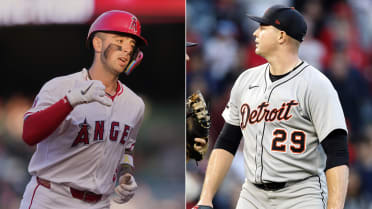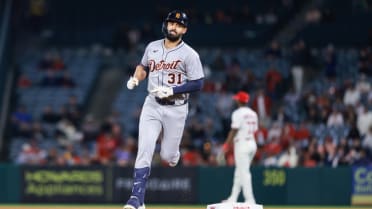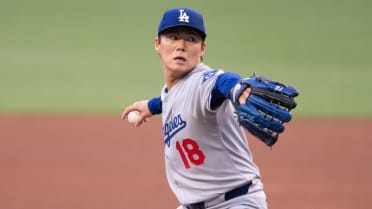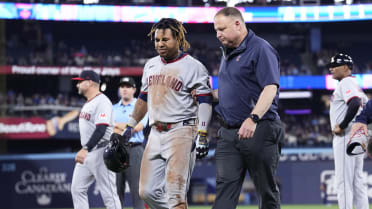The Twins, for years, have been plagued by below-average outfield defense. In 2016, they continued to have below-average outfield defense. The trend continued! But at the same time, they also managed to have spectacular outfield defense, some of the best in the game. We know that these statements seem to contradict one another, but we'll explain -- and, hopefully, show why there might finally be some reason for hope for Minnesota's outfield defense.
By any metric you might want to use, the Twins' outfield hasn't been a strength for a long time. According to Statcast™, the group converted the fifth-lowest percentage of catchable batted balls into outs last year. According to Defensive Runs Saved, their -30 runs mark was the third worst in 2016, and if you look at the period spanning the last five seasons, from 2012-16, their -84 runs was also third-worst, a full 275 runs worse than the No. 1 Royals. Given that Kansas City had 79 more wins in that span, and the shorthand is "10 runs equal approximately one win," you could argue that about a third of the difference in team success was in just outfield defense.
Given that Minnesota has traditionally had a pitch-to-contact staff that allows a ton of balls in play, putting a leaky outfield defense behind that has never seemed like a recipe for success, an issue we've been following for years. Even if you don't care for the metrics, manager Paul Molitor specifically told the local media last summer that the outfield defense remained a serious issue.
OK, so that's the bad news. What's the good news?
Earlier this month, we rolled out our latest Statcast™ metric, "Catch Probability." As we explained in the introductory article, every tracked batted ball can be assigned a catch percentage based on how far the fielder had to go to catch it and how much time he had to get there, from pitcher's release. (We'll upgrade it to include direction and proximity to the wall as 2017 goes on, and work to include infield plays in the future.)
Since we can put a number on every outfield ball, we assigned each band quality ratings, so the absolute best plays, the balls that are caught between one percent and 25 percent of the time, are "Five-Star Plays." Between 26 percent and 50 percent are "Four-Star Plays," and so on down the line. In addition to being easy to understand, it also allows us to do fun things like rank Billy Hamilton's five most spectacular catches of the season. (Spoiler: They are all wonderful.)
If we can do that for players, we can do that for teams, too, and here's where this is relevant to the Twins. In 2016, there were over 260 plays considered to be "Five-Star Plays," the cream of the crop. Check out which group tied for first place:
Most "Five-Star Plays" by an outfield in 2016
18 -- Twins
18 -- Reds
17 -- Royals
14 -- Braves
13 -- White Sox
You're not surprised to see the Reds there (largely due to Hamilton) or the Royals (thanks to Jarrod Dyson and Lorenzo Cain) or the Braves (fueled by Ender Inciarte) or the White Sox (who benefited from Adam Eaton before he was traded to Washington). But the Twins? The team with a history of subpar defense, who still dealt with a lot of those issues last year? How did they make the cut?
Well, there's a few answers to that. The first is that Byron Buxton is spectacular, and let's get right to an example of him doing something great:
Due to injuries and his up-and-down offense before a scorching-hot September tear, Buxton only played 53 percent of Minnesota's defensive innings in center field last year, a number he's sure to top in 2017, assuming health. Despite that, of the 123 outfielders to get at least 10 Five-Star opportunities last year, his six successful Five-Star catches was tied for sixth. On a percentage basis, Buxton's 24 percent conversation rate in the Five-Star band was eighth-best.
More Buxton in center means less Danny Santana in center, and that's obviously a good thing. But you've seen Buxton fly, and you know he can be elite. Would you be surprised to know that right up there with Buxton in Five-Star Plays made was right fielder Max Kepler?
Kepler's conversation rate in the Five-Star band was a lower 19 percent, as he played far more often than Buxton did. Like Buxton, he played less than two-thirds of the innings at his position, as he didn't come up to stay until June, and more Kepler in right means less Oswaldo Arcia (now with Arizona) and Miguel Sano (now playing third base, though he did manage two Five-Star Plays of his own in the outfield).
Yet while Kepler is capable of the great play, there's still work to be done on overall consistency. While Buxton, for example, hauled in 88 percent of the potentially catchable balls hit to him, Kepler managed to get only 82 percent, highlighted by some high-profile mistakes like this ill-advised dive that Melvin Upton Jr. turned into an inside-the-park home run. Like with the bat, consistency is a skill on defense as well, though Kepler only just turned 24 in February.
It's slightly different in left, to be fair. While Eddie Rosario is capable of making spectacular plays as well, like this one where he robbed Eaton…
… he also made only 14 plays all year with a Catch Probability less than 75 percent. Buxton, for example, made 30 in about the same amount of playing time. Fourth outfielder Robbie Grossman, meanwhile, came in as one of the weakest-rated outfielders in the game, getting to only 71 percent of catchable balls (where the Major League average was 83 percent). Of the 128 outfielders with at least 100 catchable opportunities, that was tied with Philadelphia's Tyler Goeddel for last, just behind Matt Kemp and Domingo Santana, though it's something both player and team are well aware of as they work to improve his glove to match his productive bat.
Suddenly, you realize how this could be better. Arcia's indifferent defense is gone. Santana is unlikely to see much time. Sano's limited range won't be seen in right. Buxton and Kepler should see far more playing time. Grossman is working hard to improve. Throw in the fact that this group already looked like they'd have what might be 2017's strongest throwing arms, and you can see why things are immediately looking up.
Three years ago, the 2014 Twins outfield of Jason Kubel, Chris Parmelee, Aaron Hicks and Arcia had the seventh-worst DRS score of the 420 team seasons on record dating back to 2003. Two years ago, Torii Hunter's final season helped counteract some good work from Rosario and Buxton. One year ago, the pieces started to fall into place. This year could finally be the year -- the one where Minnesota's outfield finally starts giving that pitching staff the support it's long needed.
Mike Petriello is an analyst for MLB.com and the host of the Statcast podcast. He has previously written for ESPN Insider and FanGraphs.



